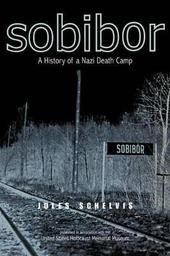
|
Sobibor: A History of a Nazi Death Camp
Paperback / softback
Main Details
| Title |
Sobibor: A History of a Nazi Death Camp
|
| Authors and Contributors |
By (author) Jules Schelvis
|
|
Translated by Karin Dixon
|
|
Edited by Professor Bob Moore
|
| Physical Properties |
| Format:Paperback / softback | | Pages:320 | | Dimensions(mm): Height 234,Width 156 |
|
| Category/Genre | The Holocaust |
|---|
| ISBN/Barcode |
9781845204198
|
| Classifications | Dewey:940.5318092 |
|---|
| Audience | | General | | Tertiary Education (US: College) | |
|---|
| Illustrations |
45 b&w illustrations, bibliography, index
|
|
Publishing Details |
| Publisher |
Bloomsbury Publishing PLC
|
| Imprint |
Berg Publishers
|
| Publication Date |
1 July 2007 |
| Publication Country |
United Kingdom
|
Description
Auschwitz. Treblinka. The very names of these Nazi camps evoke unspeakable cruelty. Sobiboer is less well known, and this book discloses the horrors perpetrated there.Established in German-occupied Poland, the camp at Sobiboer began its dreadful killing operation in May 1942. By October 1943, approximately 167,000 people had been murdered there. Sobiboer is not well documented and, were it not for an extraordinary revolt on 14 October 1943, we would know little about it. On that day, prisoners staged a remarkable uprising in which 300 men and women escaped. The author identifies only forty-seven who survived the war.Sent in June 1943 to Sobiboer, where his wife and family were murdered, Jules Schelvis has written the first book-length, fully documented account of the camp. He details the creation of the killing centre, its personnel, the use of railways, selections, forced labour, gas chambers, escape attempts and the historic uprising.In documenting this part of Holocaust history, this compelling and well-researched account advances our knowledge and understanding of the Nazi attempt to annihilate the European Jews.Published in association with the United States Holocaust Memorial Museum.
Author Biography
Jules Schelvis is a Holocaust survivor and independent scholar. In 1943, he was deported to Sobibor, where he lost his wife and family. He lives in the Netherlands. Bob Moore is Reader in History at the University of Sheffield.
ReviewsThis is a remarkable book by a remarkable author. Jules Schelvis was himself a survivor of several Nazi camps, including a short stay of a few hours in Sobibor. After his retirement, he made it his mission to write the first detailed and scholarly book about this camp. His motivation was without doubt very personal and very emotional, as his young wife and her family were murdered in Sobibor. In spite of that (or maybe because of it) his research was scrupulously undertaken and his finished text is marked out by its precision and scholarly distance. This book is both an excellent historical study and also a monument to the events it examines.' Professor Hans Blom, University of Amsterdam, and Director, Netherlands Institute for War Documentation 'Every historian is motivated by the urge to leave not one stone unturned. This is especially true for Jules Schelvis, who, after many years of archival research, managed to uncover the sinister facts of the extermination camp of Sobibor, dug up from the forgotten past.' NRC Handelsblad 'This is one of the very few books that deals with what made the Nazi genocide of the Jews unprecedented: the death camp in which Jews were killed on an assembly-line basis, as Raul Hilberg has put it. Three of these camps have existed, Belzec, Sobibor and Treblinka. Belzec and Treblinka are relatively well known. In this magnificent study, the survivor and self-trained historian Jules Schelvis has written the history of an isolated place in Eastern Poland, Sobibor, close to the borders with Byelorussia and Ukraine, where 170,000 Jews who had lived in Poland, the Netherlands, Slovakia, Germany, the Soviet Union, Austria and France were murdered in 1942-43 - the most of them upon arrival. Nowadays there is a monument in Treblinka, which dates from the Stalinist period. And there is a museum in Belzec, which was built more recently. In Sobibor there is practically nothing, except a railway track and an abandoned nursery with some photographs in it. So, this book literally is all there is about the death of 170,000 humans.' Professor Johannes Houwink ten Cate, Professor of Holocaust and Genocide Studies, University of Amsterdam
|